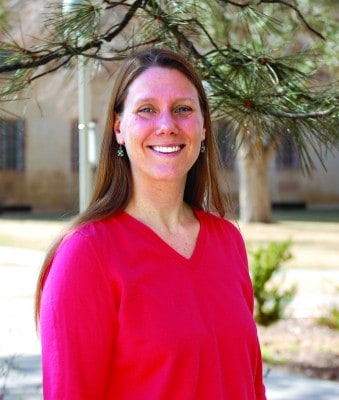Dr. Wendy Madigosky ’95
Dr. Wendy Madigosky ’95: Training Tomorrow’s Doctors
by Ann Pauley

Dr. Wendy Madigosky ’95
Wendy Madigosky ’95 did not plan to be a doctor. She loved science and envisioned a career as a researcher. “Then I took a bioethics course with Sr. Helen James John, SND, ’51, and I was fascinated by the connections between ethics, theology and medicine,” she recalls. “I didn’t think about being a doctor until I took that course. Then, in class, I saw how I could combine my love of science with the ethical issues that you face in medicine.”
Today, Madigosky is training future doctors as an assistant professor of family medicine at the University of Colorado School of Medicine in Denver.
Madigosky, the daughter of Susan Watson Madigosky ’62, was a Clare Boothe Luce Women in Math, Science and Engineering Scholar at Trinity. She majored in biology and, inspired by her professor, minored in bioethics and theology. She graduated summa cum laude and was elected to Phi Beta Kappa. She earned her medical degree at George Washington University, then completed her residency and specialty training in family medicine at the University of Colorado. She earned a master of science in public health at the University of Missouri-Columbia, with a concentration in medical education.
Since 2006, Madigosky has been the director of the foundations of doctoring curriculum at the University of Colorado School of Medicine. “Traditionally, medical students would focus on science courses their first two years, then engage in clinical practice the next two years,” explains Madigosky. “But through the foundations of doctoring curriculum, we engage the students in the clinical experience right from the start. We teach them to think, feel and behave differently – to think, feel and behave like doctors.” For example, students learn medical interviewing skills and physical examination skills and are given opportunities to reflect on their professional development as they become doctors.
A major component of the curriculum is a preceptorship, in which students are matched up with practicing physicians and they start putting their skills into practice in a clinical setting.
“This is the most successful part of the program,” says Madigosky. “Students actively engage in patient care right in their first year. After just one day of preceptorship, they can see how what they are learning in class relates to patient care.”
As curriculum director, Madigosky oversees the content of the curriculum and how it is delivered, and ensures that it is developmentally appropriate for the students’ growth. “I also make sure that we have established appropriate competencies, and are able to assess students in achieving those competencies.”
Madigosky enjoys teaching students, and among her favorite topics are small group discussions on professionalism, in which students discuss issues that a first-year student would encounter, such as patient privacy. She also teaches students how to present information about patients to their supervising physicians and how to focus on quality improvement. “We don’t want them to focus just on the skills and knowledge,” she notes. “We want them to develop an attitude of how to improve systems, how to improve our interactions with patients – and, ultimately, how to improve patient care.”
Improving patient care and fostering the collaboration between nursing and medical students are the goals of an initiative in which Madigosky is very engaged. “We bring these students together to collaborate on improving systems that will enhance patient care. For example, nursing and medical students talk about how to make sure that patients are seamlessly transferred from the intensive care unit to a regular floor and are discharged in an efficient way. They then make recommendations for systemic improvements. We believe that by learning this collaborative approach as students, they will, as practicing doctors and nurses, collaborate to improve patient care systemically.”
For Madigosky, collaboration is the theme for the future of her curricular work. “That’s the next challenge for us,” she says. “How do we train health professionals to work together? They all need their own skill sets, but we need to teach them how to work collaboratively. It is very exciting to be a part of figuring that out at the curricular level.”
Madigosky spends about 20 percent of her time seeing patients in a clinical setting. As a family medicine doctor, she sees patients from newborns to teenagers to adults. “I like connecting with individuals and families,” she says. “I focus on keeping my patients healthy and my patients appreciate that I am there for them. I value my time with my patients – it gives me insight into teaching and keeps me balanced.”
Balance is what Madigosky strives to achieve as she and her husband, Craig, raise a young family; Isaac is 4 and Sarah is just 2. “Between my family, my clinical practice, teaching and directing the foundation of doctoring curriculum, I stay very busy, but I like it that way!”
“I consider myself a medical educator,” says Madigosky. “Even when I was at Trinity I knew I wanted to teach. At Trinity, I was impressed by the availability of faculty and administrators and by the opportunities to be mentored. For me, Trinity was an environment that supported and engaged students and built confidence in many areas. I hope that through the work I do today, I can provide that same environment to my students.”